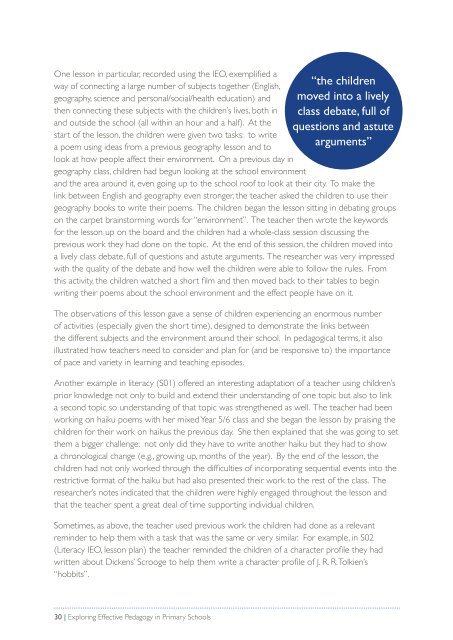Pearson-Exploring-Effective-Pedagogy-in-Primary-Schools
Pearson-Exploring-Effective-Pedagogy-in-Primary-Schools
Pearson-Exploring-Effective-Pedagogy-in-Primary-Schools
You also want an ePaper? Increase the reach of your titles
YUMPU automatically turns print PDFs into web optimized ePapers that Google loves.
One lesson <strong>in</strong> particular, recorded us<strong>in</strong>g the IEO, exemplified away of connect<strong>in</strong>g a large number of subjects together (English,geography, science and personal/social/health education) andthen connect<strong>in</strong>g these subjects with the children’s lives, both <strong>in</strong>and outside the school (all with<strong>in</strong> an hour and a half). At thestart of the lesson, the children were given two tasks: to writea poem us<strong>in</strong>g ideas from a previous geography lesson and tolook at how people affect their environment. On a previous day <strong>in</strong>geography class, children had begun look<strong>in</strong>g at the school environment“the childrenmoved <strong>in</strong>to a livelyclass debate, full ofquestions and astutearguments”and the area around it, even go<strong>in</strong>g up to the school roof to look at their city. To make thel<strong>in</strong>k between English and geography even stronger, the teacher asked the children to use theirgeography books to write their poems. The children began the lesson sitt<strong>in</strong>g <strong>in</strong> debat<strong>in</strong>g groupson the carpet bra<strong>in</strong>storm<strong>in</strong>g words for “environment”. The teacher then wrote the keywordsfor the lesson up on the board and the children had a whole-class session discuss<strong>in</strong>g theprevious work they had done on the topic. At the end of this session, the children moved <strong>in</strong>toa lively class debate, full of questions and astute arguments. The researcher was very impressedwith the quality of the debate and how well the children were able to follow the rules. Fromthis activity, the children watched a short film and then moved back to their tables to beg<strong>in</strong>writ<strong>in</strong>g their poems about the school environment and the effect people have on it.The observations of this lesson gave a sense of children experienc<strong>in</strong>g an enormous numberof activities (especially given the short time), designed to demonstrate the l<strong>in</strong>ks betweenthe different subjects and the environment around their school. In pedagogical terms, it alsoillustrated how teachers need to consider and plan for (and be responsive to) the importanceof pace and variety <strong>in</strong> learn<strong>in</strong>g and teach<strong>in</strong>g episodes.Another example <strong>in</strong> literacy (S01) offered an <strong>in</strong>terest<strong>in</strong>g adaptation of a teacher us<strong>in</strong>g children’sprior knowledge not only to build and extend their understand<strong>in</strong>g of one topic but also to l<strong>in</strong>ka second topic so understand<strong>in</strong>g of that topic was strengthened as well. The teacher had beenwork<strong>in</strong>g on haiku poems with her mixed Year 5/6 class and she began the lesson by prais<strong>in</strong>g thechildren for their work on haikus the previous day. She then expla<strong>in</strong>ed that she was go<strong>in</strong>g to setthem a bigger challenge: not only did they have to write another haiku but they had to showa chronological change (e.g., grow<strong>in</strong>g up, months of the year). By the end of the lesson, thechildren had not only worked through the difficulties of <strong>in</strong>corporat<strong>in</strong>g sequential events <strong>in</strong>to therestrictive format of the haiku but had also presented their work to the rest of the class. Theresearcher’s notes <strong>in</strong>dicated that the children were highly engaged throughout the lesson andthat the teacher spent a great deal of time support<strong>in</strong>g <strong>in</strong>dividual children.Sometimes, as above, the teacher used previous work the children had done as a relevantrem<strong>in</strong>der to help them with a task that was the same or very similar. For example, <strong>in</strong> S02(Literacy IEO, lesson plan) the teacher rem<strong>in</strong>ded the children of a character profile they hadwritten about Dickens’ Scrooge to help them write a character profile of J. R. R. Tolkien’s“hobbits”.30 | <strong>Explor<strong>in</strong>g</strong> <strong>Effective</strong> <strong>Pedagogy</strong> <strong>in</strong> <strong>Primary</strong> <strong>Schools</strong>


